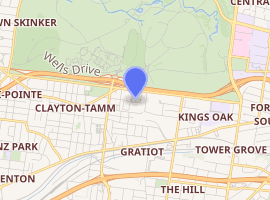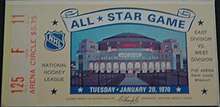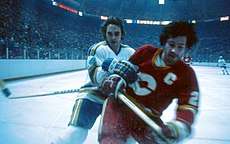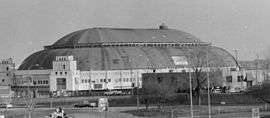St. Louis Arena
St. Louis Arena (known as the Checkerdome from 1977 to 1983) was an indoor arena in St. Louis, Missouri. The country's second-largest indoor entertainment venue when it opened in 1929, it was home to the St. Louis Blues and various other sports franchises. The Arena sat across I-64 from Forest Park's Aviation Field.
.jpg) | |

| |
| Former names | Checkerdome (1977–1983) |
|---|---|
| Location | 5700 Oakland Avenue St. Louis, Missouri |
| Coordinates | 38°37′45″N 90°16′58″W |
| Owner | City of St. Louis[1] |
| Operator | City of St. Louis[1] |
| Capacity | Ice hockey: 14,200 (1929–1968) 14,500 (1968–1969) 15,500 (1969–1970) 17,776 (1970–1971) 17,821 (1971–1972) 18,005 (1972–1974) 18,008 (1974–1975) 18,006 (1975–1978) 17,968 (1978–1985) 17,640 (1985–1988) 17,188 (1988–1994) |
| Construction | |
| Broke ground | 1927 |
| Opened | September 23, 1929 |
| Closed | May 23, 1994 |
| Demolished | February 27, 1999 |
| Construction cost | US$1.5 million |
| Architect | Gustel R. Kiewitt and Herman M. Sohrmann |
| General contractor | Boaz-Kiel Construction Company |
| Tenants | |
| St. Louis Flyers (AHA/AHL) (1929–1953) St. Louis Eagles (NHL) (1934–1935) Chicago Black Hawks (NHL) (occasional use; 1951–1959) Toledo-St. Louis Mercurys (IHL) (1959–1960) St. Louis Braves (CHL) (1963–1967) St. Louis Blues (NHL) (1967–1994) St. Louis Hawks (NBA) (occasional use; 1955–1968) St. Louis Bombers (NBA) (1946–1950) St. Louis Stars (NASL) (1971, 1974) Spirits of St. Louis (ABA) (1974–1976) St. Louis Steamers (MISL) (1979–1988) St. Louis Storm (MISL) (1989–1992) St. Louis Ambush (NPSL) (1992–1994) St. Louis Vipers (RHI) (1993–1994) Saint Louis Billikens men's basketball (NCAA) (1968–1973 and 1991–1994) Saint Louis Billikens men's ice hockey (1970–1979) | |
The Arena hosted conventions, concerts, political rallies, horse shows, circuses, boxing matches, professional wrestling, Roller Derby competitions, indoor soccer matches, the 1973 and 1978 NCAA men's basketball Final Four, the NCAA Men's Midwest Regional finals in 1982, 1984, and 1993, the 1992–94 Missouri Valley Conference men's basketball tournament, and the 1975 NCAA Frozen Four ice hockey finals.
It was demolished in 1999.
History
At the conclusion of the 1904 World's Fair, St. Louis ended its long tradition of annually hosting large indoor agriculture and horse shows. The city tore down its huge St. Louis Exposition and Music Hall and built the St. Louis Coliseum which was aimed at individual events such as boxing matches.
In 1928 the National Dairy Show offered the city the opportunity to become the permanent location for its annual two-week meeting of dairymen and their prize animals. With no public funds available, a group of businessmen raised private funding for what was projected as a $2 million building. The National Exposition Company in charge of the project hired Gustel R. Kiewitt as architect and the Boaz-Kiel Construction Company as general contractor.
Kiewit's design called for a lamella roof supported by 20 cantilever steel trusses, eliminating the need for view-obscuring internal support pillars. The lamella design consisted of Douglas fir ribs, 3.75 inches (9.5 cm) thick, 17.5 inches (44 cm) wide and 15 feet (4.6 m) long, fitted together diagonally and giving the appearance of fish scales. The huge structure was completed in 1929, just over a year after construction began. At 476 feet (145 m) long and 276 feet (84 m) wide, it was behind only Madison Square Garden as the largest indoor entertainment space in the country. A 13-story building could have been erected inside of it.
The Arena was not well-maintained after the 1940s, and its roof was damaged by a February 1959 tornado. After repairs, it was re-opened as the home of the Central Hockey League's St. Louis Braves, a Chicago Black Hawks farm team. The renovations included the removal of the fencing that enforced segregation, dating back to the time of the St. Louis Eagles.[2]
On March 19, 1971 the St. Louis Stars hosted the 1971 NASL Professional Hoc-Soc Tournament here, which was the first indoor soccer tournament sanctioned by a Division One professional league in U.S. history.[3]
In the 1973 NCAA Basketball Final, the UCLA Bruins and legendary coach John Wooden defeated Memphis State 87–66, behind 44 points from Bill Walton who went 21 of 22 from the floor. Over 19,000 were in attendance at the Arena.[4]
On February 13, 1974, the St. Louis Stars played host to the Red Army team at the Arena in the final match of Russian squad's three-city indoor soccer tour of North America. Attendance for the match was 12,241.[5][6][7][8]
In the 1978 NCAA Basketball Final, the Kentucky Wildcats and coach Joe B. Hall defeated Duke 94-88, led by the 41-point effort of Jack Givens.[9]
From 1980 to 1993, St. Louis Arena was the site of the Braggin' Rights basketball game played between the University of Missouri and the University of Illinois.
Spirits of St. Louis – ABA Era (1974–76)
After the 1968 departure of the NBA's St. Louis Hawks, the Spirits of St. Louis brought professional basketball back to St. Louis when the Carolina Cougars franchise moved to St. Louis. The Spirits played in the Arena for the final two seasons of the American Basketball Association (ABA), 1974–75 and 1975–76.[10] Their announcer on KMOX radio was a young Bob Costas. Young players such as Steve Jones ("Snapper", now a TV analyst), Marvin Barnes ("Bad News), Maurice Lucas and Moses Malone all played for the Spirits during their tenure at the Arena. The team was not included in the ABA–NBA merger in 1976, when the Indiana Pacers, San Antonio Spurs, Denver Nuggets and New York Nets joined the NBA. The Spirits and the Kentucky Colonels were disbanded.[11] Spirits owners Ozzie and Daniel Silna pulled off a coup in their dissolution agreement when the ABA–NBA merger was finalized. The Silnas negotiated to receive a portion of TV monies in perpetuity, a deal that netted them over $250 million[12] before they were bought out by the NBA in 2014 for a reported $500 million.[13]
The St. Louis Blues era (1967–1994)


By the time the NHL's St. Louis Blues began playing at the Arena, it had fallen into such poor condition that it had to be heavily renovated in time for the 1967–68 season. As a condition of getting the expansion franchise, Blues owner Sid Salomon Jr. purchased the Arena from the Chicago Black Hawks, and spent several million dollars renovating the building and adding some 3,000 seats to bring the total to almost 15,000. It never stopped being renovated from that day on, and held almost 20,000 seats by the time the Blues left the Arena in 1994. Many fans considered its sight lines the best of any arena in the league, which is remarkable considering that it was not originally built for hockey. It was also known as one of the loudest arenas in the league.
In 1977, the Arena and the Blues were purchased by Ralston Purina, which rechristened the building the Checkerdome after the company's checkerboard logo. By 1983, the cereal and pet food corporation had lost interest in the Blues and the Arena, and forfeited the team to the league. The team was nearly moved to Saskatoon, Saskatchewan before it was purchased by Harry Ornest, a Los Angeles-based businessman, who promptly returned the Arena to its original name.
After the Blues moved to their new home, the venue now known as Enterprise Center, during the 1994 offseason, the final event at the St. Louis Arena was a concert by Christian artist Carman Licciardello.[14]
Closure and demolition (1994–1999)

As a condition for the private financing of the demolition of city-owned Kiel Auditorium and the construction of privately owned Kiel Center (now the Enterprise Center) on the same Downtown site, local business group Civic Progress, Inc. insisted that the Dogtown-neighborhood would not be allowed to compete with Kiel Center for any events, while the insurance burden for the building was left with the City of St. Louis. With no income allowed for the arena while insurance expenses continued, the building sat vacant while pressure built on the city government to either make it revenue-producing (essentially impossible under the Civic Progress-imposed non-compete clause) or raze it. The arena remained vacant for nearly five years.
The Arena site today
A business/residential development, The Highlands, now occupies the land that the St. Louis Arena called home, including the following:
- Three apartment buildings featuring loft-style units
- A Hampton Inn hotel, a brew pub, a coffee shop, Children's Miracle Network Hospitals of Greater St. Louis, and a yoga studio
- 1001 Highlands Plaza Drive West, an office building home to—among other businesses—the St. Louis group of iHeartMedia's radio stations (KSLZ, KATZ-FM, KLLT, KATZ, KLOU, and KSD). A grass plaza, with an oval grass section surrounded by concrete sidewalks now sits at 1001 Highlands Plaza Drive West at the location where the original arena stood.
Sports teams
Sports teams that called the Arena home include:
- St. Louis Flyers of the AHA and AHL (1929–1953)
- St. Louis Eagles of the NHL (1934–1935)
- Chicago Black Hawks of the NHL (occasional use, 1953–1959)
- St. Louis Braves of the CHL (1963–1967)
- St. Louis Blues of the NHL (1967–1994)
- St. Louis Hawks of the NBA (occasional use, 1955–1968)
- St. Louis Stars of the NASL (1971 and 1974)
- Spirits of St. Louis of the ABA (1974–1976)
- St. Louis Steamers of the MISL (1979–1988)
- St. Louis Storm of the MISL (1989–1992)
- St. Louis Ambush of the NPSL (1992–1994)
- Saint Louis University basketball team (1968–1971, 1975–1976, 1978–1982 and 1991–1994)
- Saint Louis University hockey team (1970–1979)
- St. Louis Vipers of RHI (1993–1994)
Concerts
- Led Zeppelin performed a single sold-out show on April 15, 1977 at the St. Louis Arena as part of their final North American tour.[15]
- Grateful Dead, May 15, 1977.[16]
- Ted Nugent and Sammy Hagar performed in concert on December 6, 1978. During the show a massive ice storm hit St. Louis and concert goers left the venue to find everything covered in a thick glaze of ice and serious traffic problems.
- The Bee Gees performed here on August 1, 1979 as part of their Spirits Having Flown Tour.
- Fleetwood Mac performed two sold-out shows here as part of their Tusk Tour on November 5 and 6, 1979.
- The Police Synchronicity Tour performed here on July 24, 1983 with Joan Jett & the Blackhearts as the opening act.
- Pink Floyd performed A Momentary Lapse of Reason Tour at the St. Louis Arena on November 15 and 16, 1987.[17]
- Michael Jackson performed a sold–out show in front of 36,000 people at St. Louis Arena, during his Bad World Tour on March 13, 1988. The scheduled March 12, 1988 was canceled due to sickness and rescheduled for March 14 which was also cancelled.
- Van Halen performed for their OU812 Tour on November 8 and 9, 1988[18]
- ZZ Top performed at St. Louis Arena for their Recycler World Tour on November 7 and 8, 1990.
- Metallica performed at the St. Louis Arena for their Wherever We May Roam Tour on November 24, 1991
References
- Finnigan, Joan (1992). Old Scores, New Goals: The Story of the Ottawa Senators. Quarry Press. ISBN 1-55082-041-9.
- "St. Louis Arena".
- Former Eagles player Frank Finnigan recalls the fencing while he played there in [Finnigan], pg. 123.
- Flachsbart, Harold (March 19, 1971). "Pro Soccer Sends Up Trial Balloon Tonight". St. Louis Post-Dispatch. p. 23. Retrieved August 14, 2016.
- "ESPN.com - Page2 - Kings of the Big Dance".
- "The Milwaukee Journal - Google News Archive Search". news.google.com. Retrieved April 4, 2018.
- "NASL-St. Louis Stars Friendlies".
- "International Matches in St. Louis". SoccerMadeinStLouis.com. Retrieved April 4, 2018.
- "Archived copy". Archived from the original on May 18, 2014. Retrieved May 18, 2014.CS1 maint: archived copy as title (link)
- "1978 NCAA Basketball Tournament Bracket and Results - databaseSports.com".
- "Remember the ABA: Spirits of St. Louis".
- "Remember the ABA: Houston Mavericks/Carolina Cougars/Spirits of St. Louis Year-by-Year Notes".
- Sandomir, Richard (September 6, 2012). "Former A.B.A. Owners Ozzie and Daniel Silna Earn Millions From N.B.A." – via NYTimes.com.
- Mandell, Nina (January 17, 2014). "Ending the greatest sports deal of all time will reportedly cost the NBA at least $500 million". USA Today. Retrieved May 17, 2014.
- "PowWeb" (PDF). www.stlmedia.net. Retrieved April 4, 2018.
- "Led Zeppelin Arena (St. Louis) - April 15, 1977". Led Zeppelin - Official Website. Retrieved May 21, 2018.
- "St. Louis Arena - May 15, 1977 | Grateful Dead". www.dead.net. Retrieved May 21, 2018.
- Matt. "Pink Floyd news :: Brain Damage - 1987 tour dates/concerts". www.brain-damage.co.uk. Retrieved May 21, 2018.
- "Van Halen Tour: 1988/1989". www.vharchives.com. Retrieved May 21, 2018.
| Preceded by first arena |
Home of the St. Louis Blues 1967 – 1994 |
Succeeded by Kiel Center |
| Preceded by Boston Garden Boston, Massachusetts |
Host of the Frozen Four 1975 |
Succeeded by University of Denver Arena Denver, Colorado |
| Preceded by Sports Arena The Omni |
NCAA Men's Division I Basketball Tournament Finals Venue 1973 1978 |
Succeeded by Greensboro Coliseum Special Events Center |
| Preceded by Montreal Forum Hartford Civic Center |
Host of the NHL All-Star Game 1970 1988 |
Succeeded by Boston Garden Northlands Coliseum |
| Preceded by Milwaukee Arena |
Occasional Home of the St. Louis Hawks 1955 – 1968 |
Succeeded by Alexander Memorial Coliseum |
| Preceded by Ottawa Auditorium |
Home of the St. Louis Eagles 1934 – 1935 |
Succeeded by last arena |